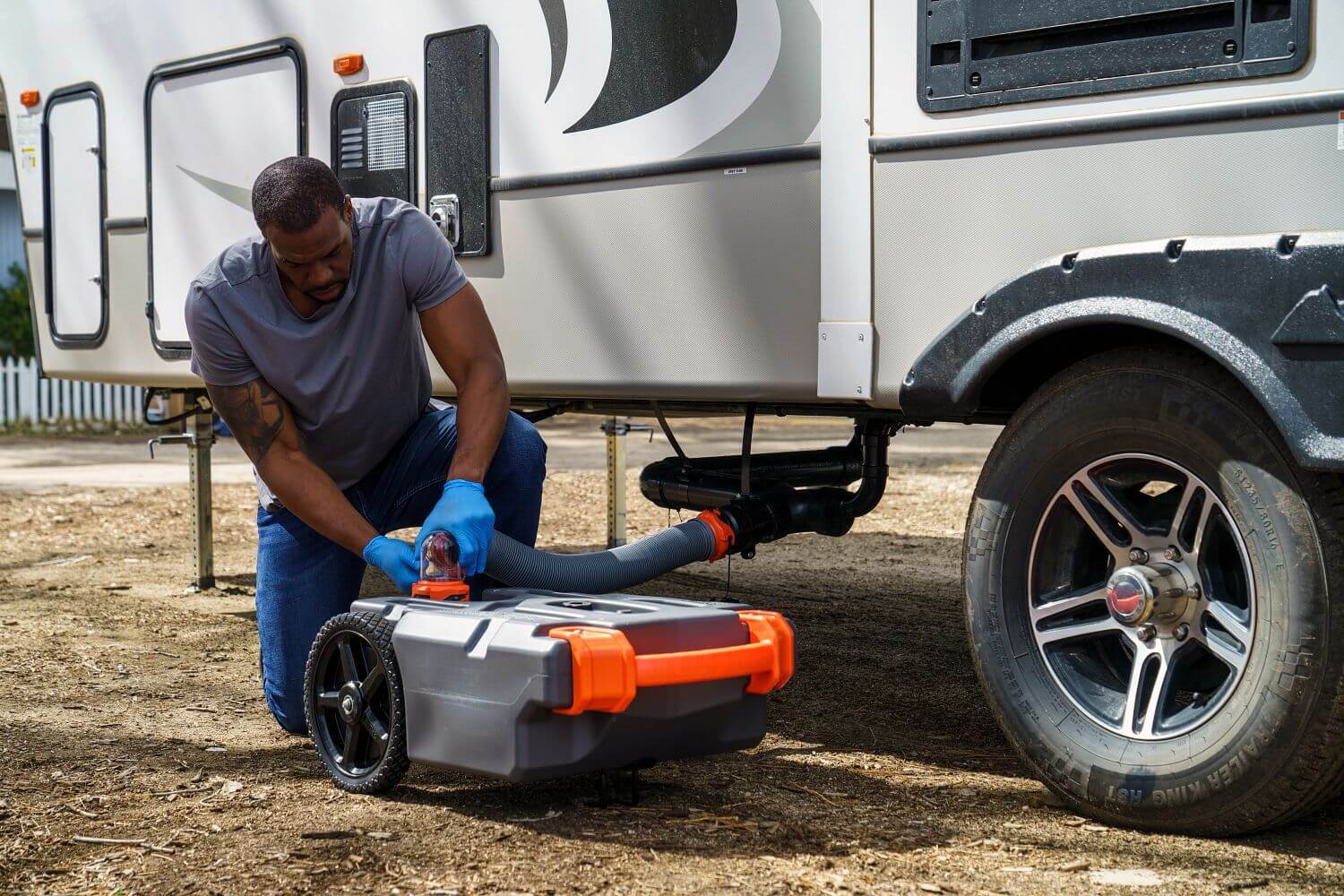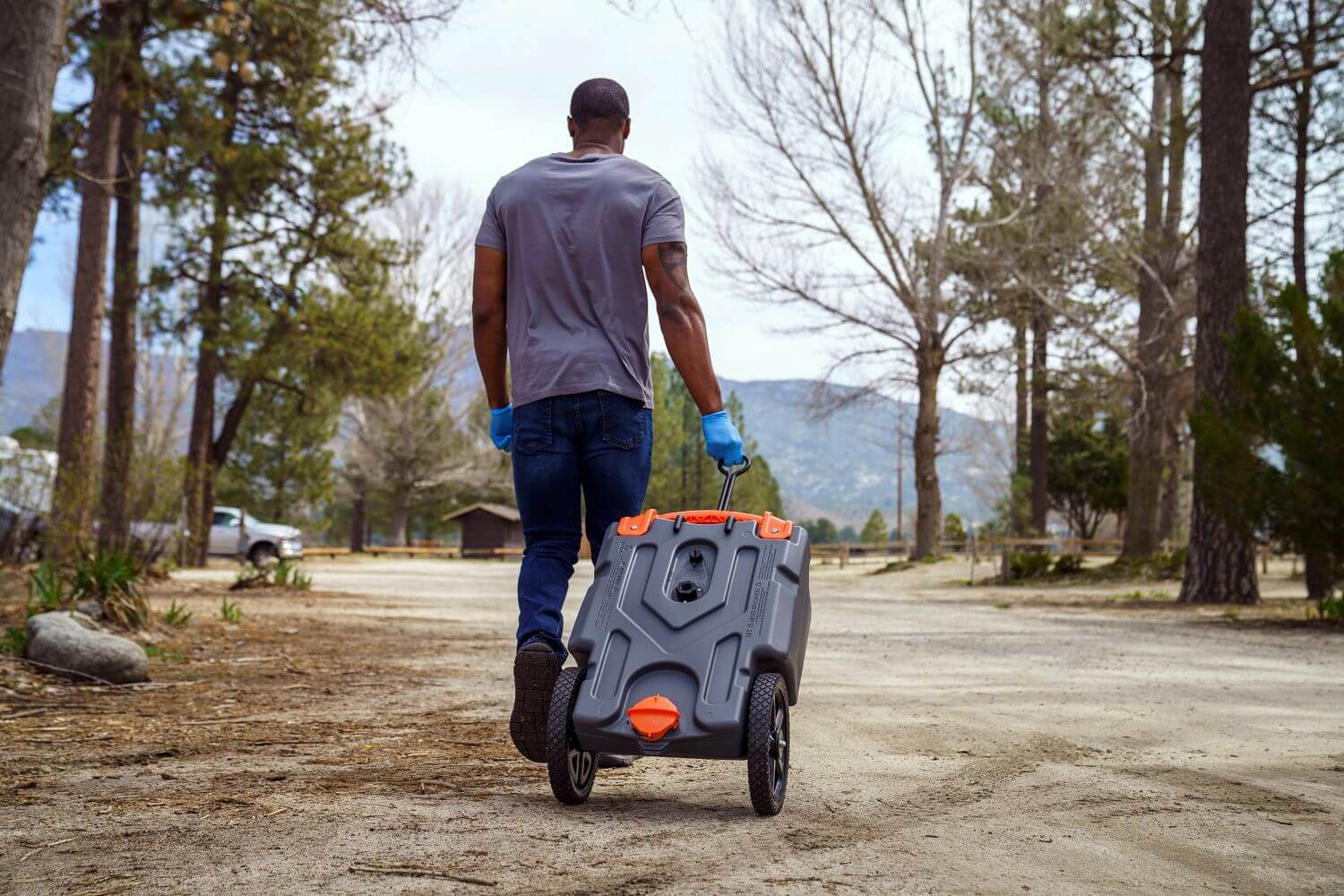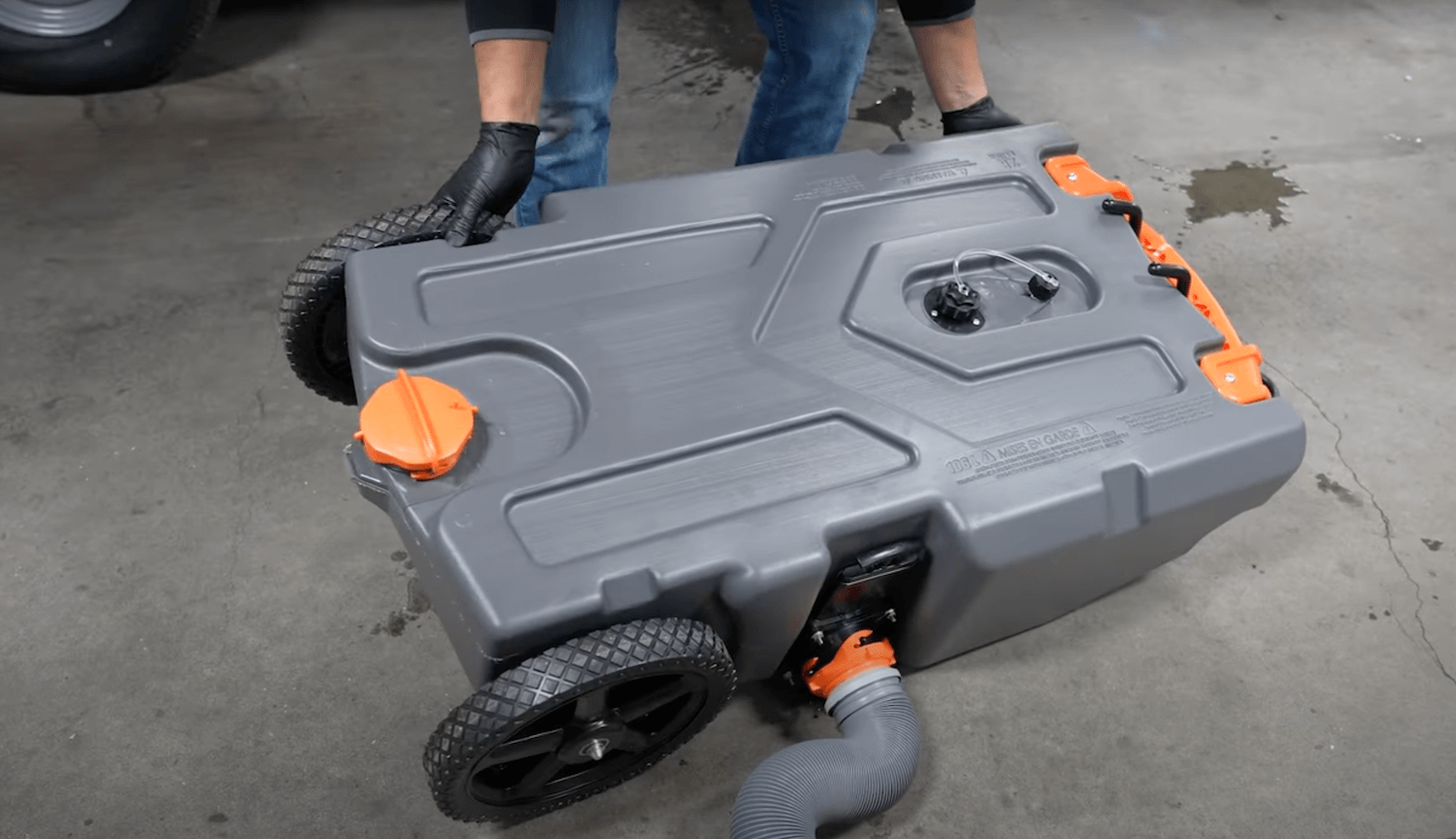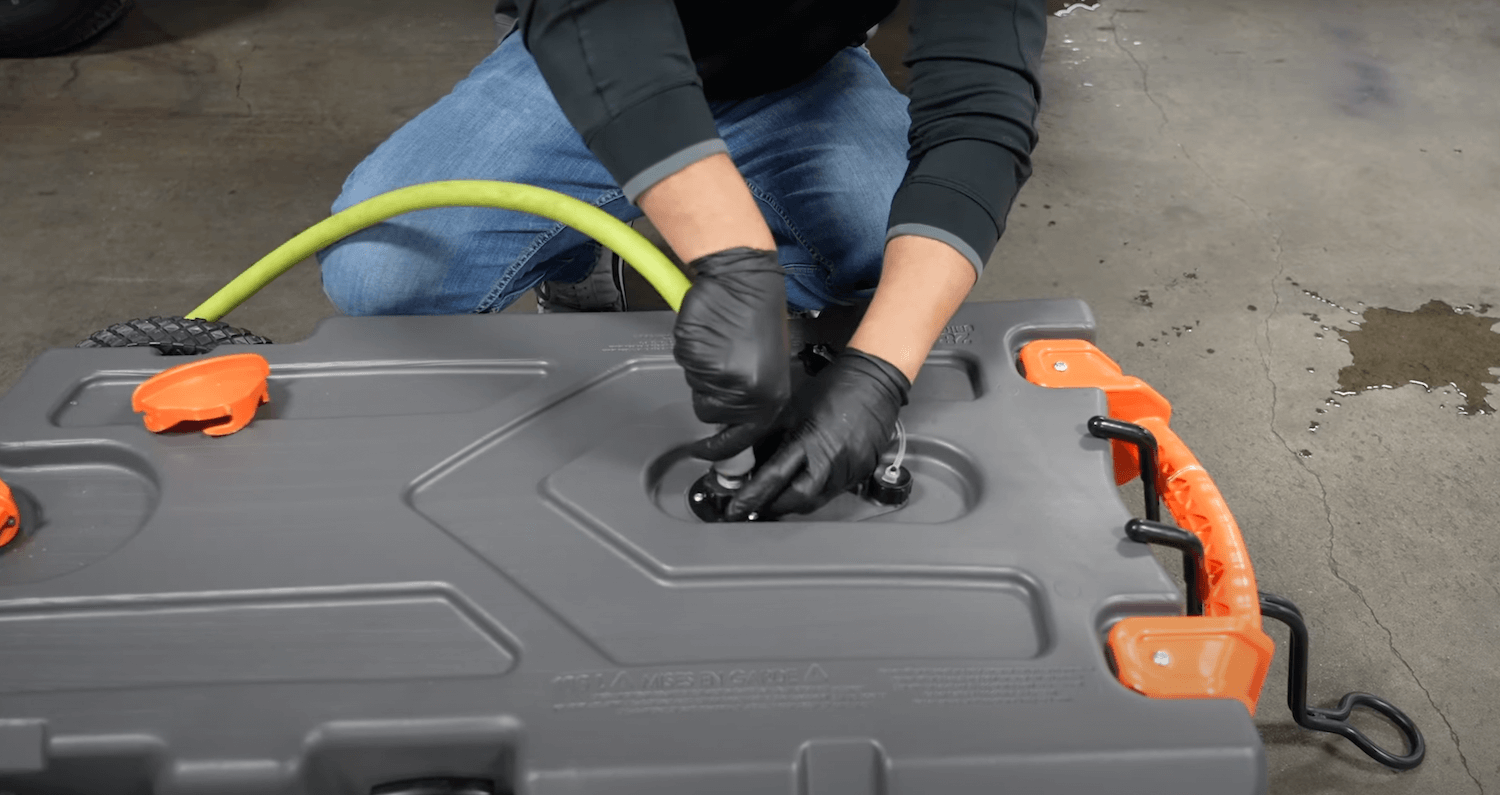Using a portable RV waste tank is similar to the process of emptying your gray and black water tanks. These portable waste tanks are ideal for long-term camping destinations with “partial hookups,” meaning – there isn’t a sewer connection at the campsite, but there might be a dump site at the campground or nearby.
Full hookup sites are often more expensive and harder to find than partial hookup sites. That’s why portable waste tanks are really useful to have on hand.
Learn more about portable waste tanks and why you might need them.
What is a Portable RV Waste Tank?

Portable RV waste tanks serve as temporary holding tanks, allowing you to transport waste to the dump station without moving your RV. Some have two round three-inch openings, and others only have one. Most also have a waste tank vent opening that serves as a pressure relief valve.
Here are a few nicknames used for portable waste water holding tanks:
- Blue boys
- Tote tank
- Honey pot
- Toilet tote
- Toot wagon
- Cutlass supreme
If your tank has two three-inch openings, the top opening is your tank fill, and the side opening is for dumping the tank. If your tank has one three-inch opening, you’ll use that to fill it, seal it during transport, and empty it again into an approved dump station.
What You’ll Need to Use a Portable RV Waste Tank





Most heavy-duty portable waste tanks for RVs come with the required sewer accessories. For sanitary use, you’ll need the following:
- Disposable gloves
- A 90-degree clear double bayonet elbow connector
- A 3-foot flexible sewer hose with bayonet and lug storage caps
- A short female-to-female flexible drain hose
- A clear bayonet elbow with a removable 4-in-1 outlet adapter
- Caps with lanyards for each three-inch opening
- A tow adapter
Again, the required accessories are included if you choose a product like this Camco Rhino Waste Tank.
How to Use a Portable RV Waste Tank
Start by consulting your tank’s manual for the manufacturer’s recommendations for safe use.
Wear gloves and any other personal protective equipment (PPE) you prefer when dealing with RV waste. Then, here’s how to use your portable RV waste tank.
Empty your RV’s Holding Tank(s) into the Portable Tank

- Connect a 90-degree clear elbow to the fill opening on top of the tank. A clear elbow is recommended to see when the tank is close to its capacity.
- Attach one end of your sewer hose to the clear elbow and the other to your RV’s holding tank outlet.
- Open the waste tank vent and empty your tanks into your tote the same way you’d empty them at a dump station – black tank first, then the gray water tank.
Technician Tip: Remember that your portable waste tank usually has less room than your RV’s tank capacity, so you may need to empty one tank at a time and make several trips.
- Close your holding tank valves and screw the waste tank vent shut before detaching the sewer hose from your RV’s tank outlet. Cap your RV’s outlet before proceeding.
For tanks with two 3-inch openings:
Connect the detached end of your sewer hose to the dump opening on the side and leave the clear elbow and the other end of the hose connected to the fill opening.
For tanks with one 3-inch opening:
Detach the sewer hose completely and cap both openings (on your RV and the portable tank). Cap the sewer hose before transporting it and the tank.
Transport your Portable Tank

Transport your portable RV waste tank to the nearest dump station. Most can be rolled by hand or attached to your truck hitch and towed at slow speeds – a recommended max of 5 MPH. If you must travel a longer distance, be careful to secure your portable tank in an open truck bed, so it doesn’t move around while in transit.
Empty Your Portable RV Waste Tank

Start by positioning your portable waste tank near the sewer drain connection at the dump station.
For tanks with two openings:
- Detach the sewer hose and 90-degree connector from the tank’s fill opening and cap the fill opening.
- Attach the 4-in-1 adapter to the 90-degree connector and screw or place the connector into the dump inlet.
- Open the waste tank vent and pull the handle on the dump opening to empty its contents. You may need to tilt your tank to empty it as the level drops.
For tanks with one opening:
- Remove the fill opening cap and attach one end of your sewer hose.
- Attach your 90-degree clear elbow connector and 4-in-1 adapter to the other end and screw or place the connector into the dump inlet.
- Open the waste tank vent and lift the end opposite the fill opening to empty it. You may need to lower and raise your tank several times to empty it completely.
How to Clean a Portable RV Waste Tank

Rinsing out your portable RV waste tank is the final step in proper use. Do this while your sewer hose is connected and the tank valve is open (for two-opening waste tanks).
- Remove the waste tank vent cap completely and attach the female-to-female drain hose adapter.
- Connect the dump station’s rinse water hose to the adapter and turn it on to let freshwater flow through your tank.
- Rock your tank gently back and forth to dislodge waste particles.
For tanks with two openings:
It may be helpful to close the side tank valve, fill your tank halfway, then rock it back and forth before opening the valve and draining the tank.
For tanks with one opening:
You’ll need to fill your tank partially, shut the water off, and tilt it to rinse and drain.
Final Safety Tips for Using a Portable RV Waste Tank
Here are a few more things to consider:
- Clean all the sewer accessories you use with your portable waste holding tank after each use.
- Remember that your portable tank’s capacity is typically less than your RV’s holding tank capacity. It may require multiple trips to empty your holding tanks completely.
- Read the manufacturer’s instructions before towing your waste tank behind your truck to ensure safe, sanitary transportation.
Now that you know how to use a portable RV waste tank, check out some of our best-selling portable tank models for dry camping or state parks without full hookups. Once you have yours, you’ll enjoy more comfortable extended stays and expanded campground options.
Do you have any questions about using an RV portable waste tank? Let us know in the comments below.









